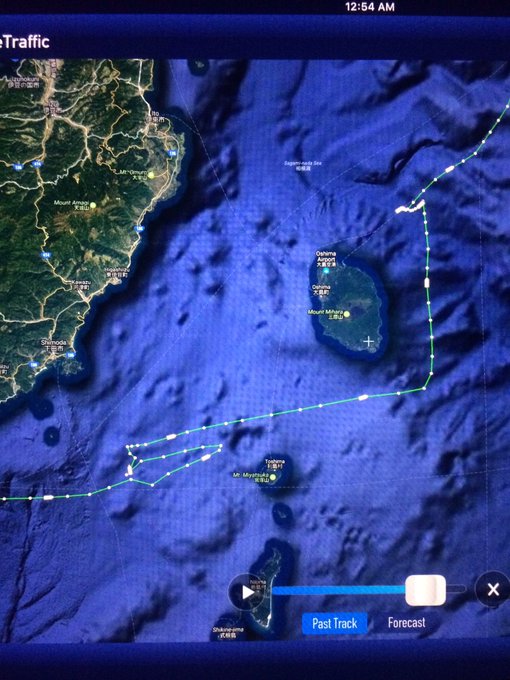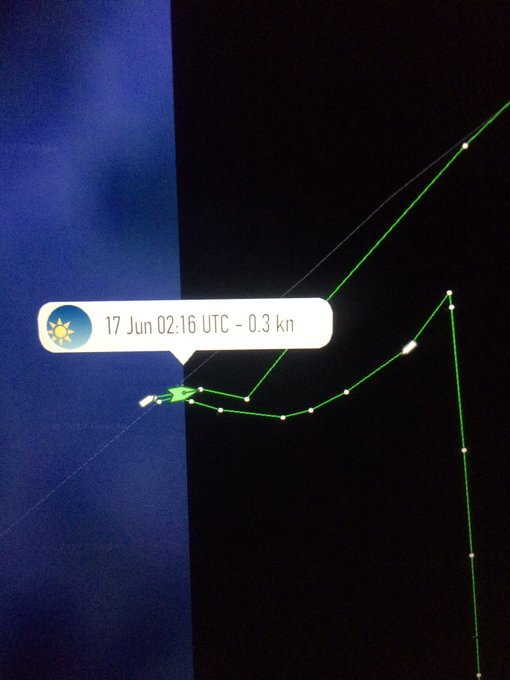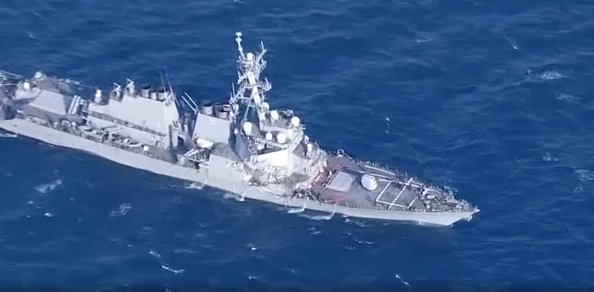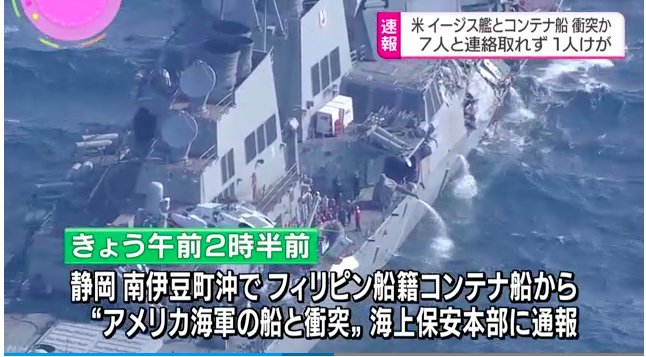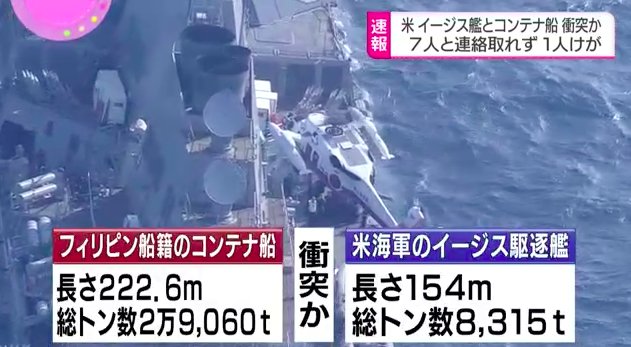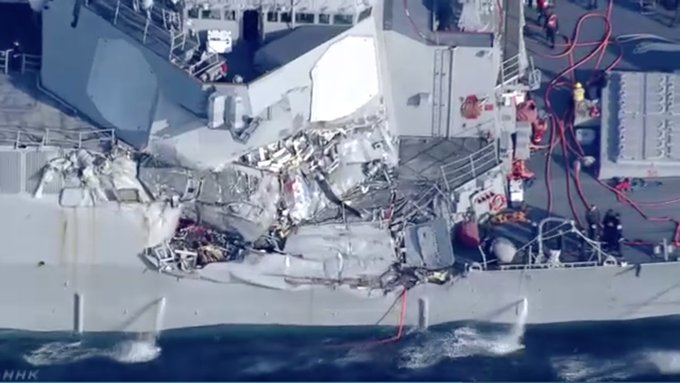
The U.S.S. Fitzgerald. (US 7th Fleet/Twitter)
Seven U.S. sailors were killedat sea after USS Fitzgerald, a Navy destroyer, collided with a merchant vessel near Yokosuka, Japan.
The Japanese Coast Guard and the ship, despite the damage and flooding it suffered in the collision, were searching for the missing sailors, according to NBC News.
However, tragically, all of the sailors were found deceased inside a damaged berthing compartment in the ship on June 17. Seven sailors are missing. “A number of Sailors’ bodies that were missing from the collision between USS Fitzgerald (DDG 62) and a merchant ship have been found,” the US 7th Fleet said in a news release on June 17, without specifying the number. However, CNN reported that all seven were found dead.
The sailors were identified as Dakota Kyle Rigsby. Shingo Alexander Douglass. Ngoc T Truong Huynh. Noe Hernandez. Carlos Victor Ganzon Sibayan. Xavier Alec Martin. Gary Leo Rehm Jr.
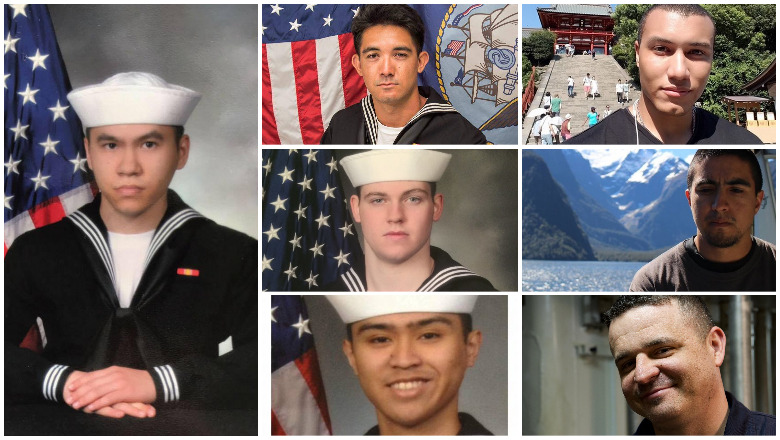
The 7 sailors who died on USS Fitzgerald.
“There are seven Sailors unaccounted for; the ship and the Japanese Coast Guard continues to search for them,” the U.S. 7th Fleet said in a statement on June 16 before dive teams found the bodies in the berthing compartment.
The cause of the collision has not been released. So far, there is no indication of any terrorism connection or intentional ramming. The incident is too fluid and new. The ship had taken on water but wasn’t sinking.
Aided by tugboats, the damaged ship made it back to Yokosuka on June 17, but the seven crew members were still missing. “This has been a difficult day,” Vice Adm. Joseph P. Aucoin, Commander, U.S. 7th Fleet, said. He, along with many family members, were on the pier when the ship arrived. “I am humbled by the bravery and tenacity of the Fitzgerald crew. Now that the ship is in Yokosuka, I ask that you help the families by maintaining their privacy as we continue the search for our shipmates.”
The company says the collision occurred early than the Navy claims, which would mean a sharp turn seen on marine tracking sites occurred after the collision, not before it, and ACX Crystal may have been operating on autopilot.
Here’s what you need to know:
1. A Container Vessel From the Philippines Ran Into the Destroyer & the First Missing Sailor Was a Gunner’s Mate From Virginia
One of the missing sailors was identified as Dakota Rigsby, a gunner’s mate in the Navy from Virginia.
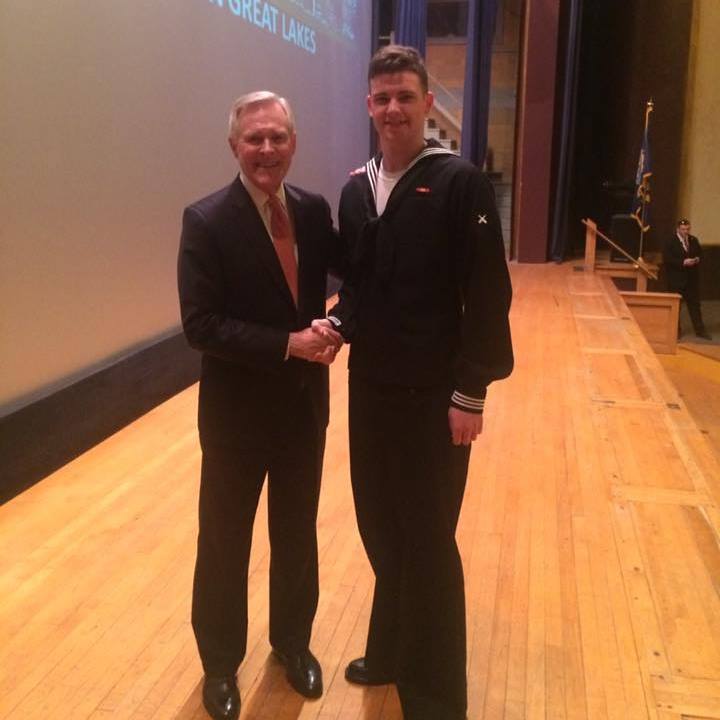
Dakota Rigsby (r). (Facebook)
The $1.5 billion Navy destroyer is a hard thing to miss: It’s 505 feet long. The collision occurred at a time when sailors would have mostly been asleep in berths that have now flooded in some cases, reported UK Daily Mail, which added that the container ship struck the Fitzgerald’s sleeping quarters.
According to NBC News, the destroyer “collided with a Philippine container vessel at approximately 2:30 a.m. Saturday local time (1:30 p.m. ET Friday), about 56 nautical miles of Yokosuka.”
The container ship was called the ACX Crystal, according to the Navy. However, the container ship was larger. The ACX Crystal is “29,060 tons and 730 feet long, according to MarineTraffic.com. Destroyers like the Fitzgerald are roughly 8,230 tons and 505 feet long.”
The ACX Crystal was built in 2008 and flies under the flag of the Philippines, according to MarineTraffic. Its home port is Manila.
“U.S. and Japanese support from the Navy, Maritime Self Defense Force and Coast Guard are in the area to ensure that the Sailors on USS Fitzgerald have the resources they need to stabilize their ship. As more information is learned, we will be sure to share to it with the Fitzgerald families and when appropriate the public. Thank you for your well wishes and messages of concern. All of our thoughts and prayers are with the Fitzgerald crew and their families,” said Adm. John Richardson, Chief of Naval Operations.
Questions remained that hadn’t yet been answered in the hours after the tragedy.
The ship suffered “damage on starboard side above & below waterline. Some flooding,” reported the Navy, but it was later running on its own power. “The collision affected Fitzgerald’s forward starboard side above and below the water line, causing significant damage and associated flooding to two berthing spaces, a machinery space, and the radio room, which damage control teams quickly began dewatering. Though the ship is back in Yokosuka it remains uncertain as to how long it will take to gain access to the spaces in order to methodically continue the search for the missing,” reported the U.S. Navy.
2. The Captain Was Injured & Airlifted From the Destroyer
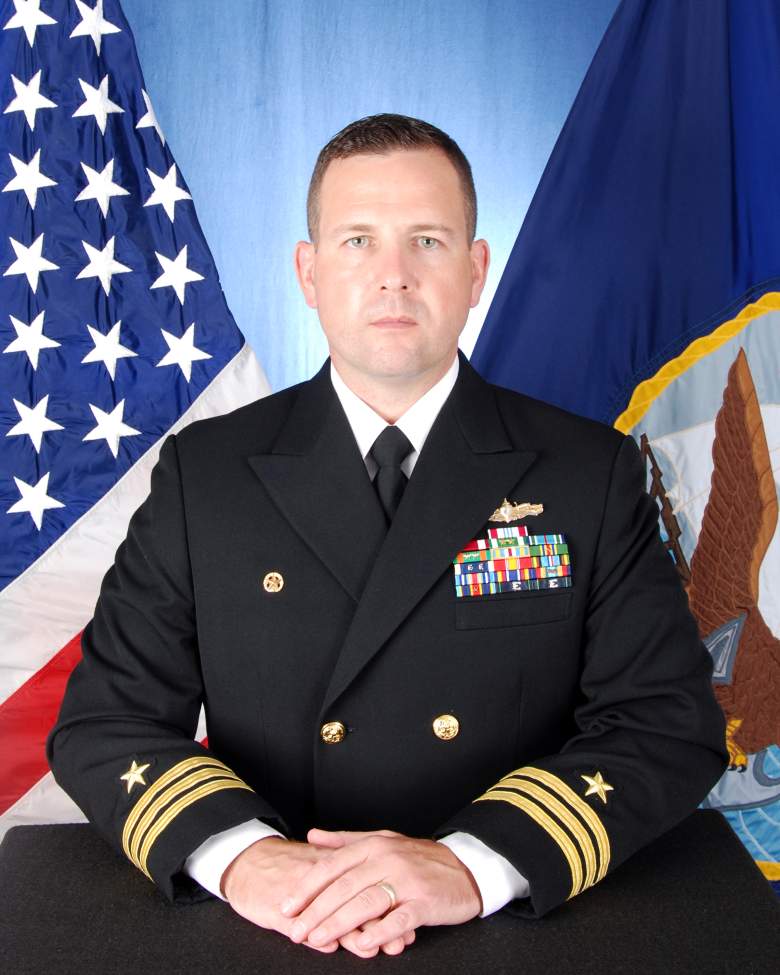
Bryce Benson. (US Navy)
Cmdr. Bryce Benson, Fitzgerald’s commanding officer, was injured in the collision and “transferred to U.S. Naval Hospital Yokosuka and is reportedly in stable condition,” according to the U.S. 7th Fleet.
In addition to the captain and those missing, two sailors suffered injuries. “2 Sailors in addition to Cmdr. Benson have been medevac’d from FITZ to USNH-Yokosuka for lacerations & bruises,” reported the U.S. 7th Fleet.
According to the Navy, Benson is a Wisconsin native.
“A native of Green Bay, Wisconsin, CDR Bryce Benson graduated from Marquette University, Milwaukee, Wisconsin in 1999 and earned his commission through the Naval ROTC program,” the Navy says.
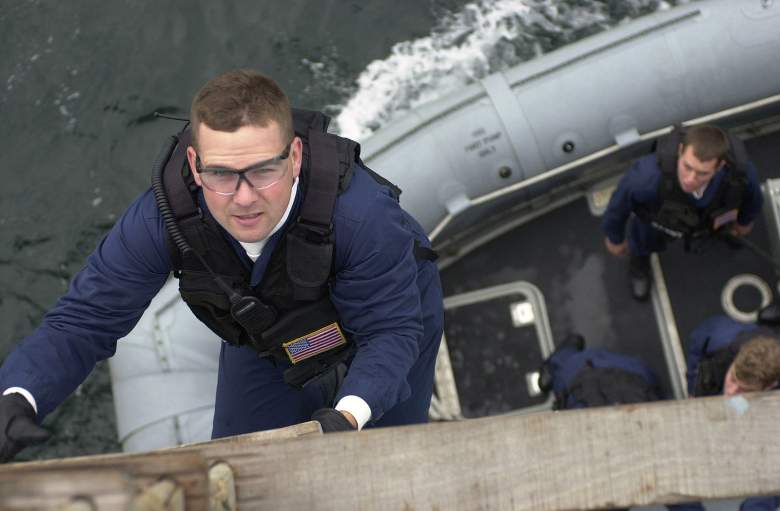
Then Lt. j.g. Bryce Benson, a boarding team member from USS Winston S. Churchill (DDG 81), climbs a pilot’s ladder during a boarding exercise on HMA Brambleleaf (A81) as part of Flag Officer Sea Training (FOST) in teh Englis Channel, Sept. 11, 2001. T
CDR Benson’s initial sea tours were on the pre-commissioned ship USS Winston S. Churchill (DDG 81) and USS Kauffman (FFG 59) “where he deployed to the 5th Fleet in support of Operation Enduring Freedom,” the Navy says. “In 2006, he was assigned as the Weapons Officer on USS FORREST SHERMAN (DDG 98) and participated in the maiden deployment to the 6th Fleet Area of Operations. In 2007, CDR Benson screened for the early command program and subsequently served as the Executive Officer then as Commanding Officer of USS GUARDIAN (MCM 5), forward deployed from Sasebo Japan, 2008-2010.”
Ashore, reported the Navy, Benson was selected for the Navy’s Washington D.C. Internship Program “where he earned a Master’s degree in Organizational Management from The George Washington University and served internships on the Navy Staff, Joint Staff, and the Office of the Secretary of Defense.”
In 2010, CDR Benson “was assigned to the Navy Personnel Command, Surface Warfare Distribution (PERS 41) as the Placement Coordinator for Amphibious and Mine Warfare Forces. In 2013, he reported to the U.S. Pacific Command where he served as the Executive Assistant to the Director for Operations (J3) and as an Integrated Air and Missile Defense Staff Officer (J36).”
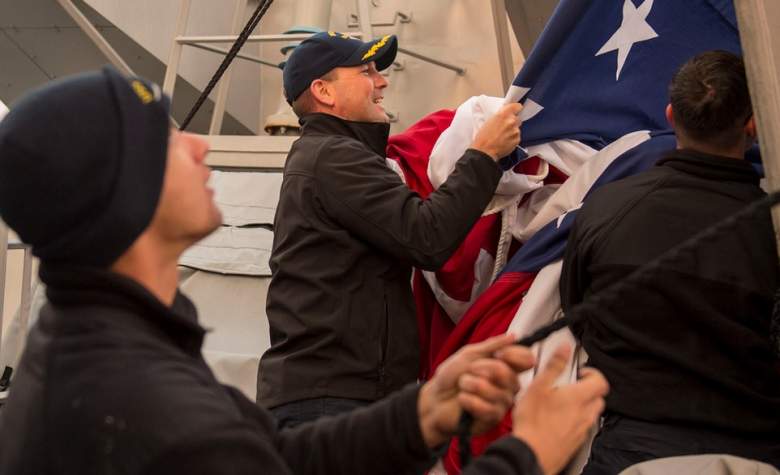
Cmdr. Bryce Benson, executive officer, assists in bringing down the battle ensign on board Arleigh Burke-class guided missile destroyer USS Fitzgerald (DDG 62). (US Navy photo)
In November 2015, Benson “reported as the Executive Officer of USS FITZGERALD (DDG 62) forward deployed from Yokosuka, Japan as part of the Surface Navy’s Command Fleet Up program,” the Navy said.
He took over as the ship’s commander in 2016, according to a Navy press release. It quoted Benson as saying, “I look forward to being with my Fitzgerald family in support of future missions and exercises. This is the best ship and the best crew on the waterfront, hands down! I am proud to work alongside the Navy’s best and brightest men and women who protect and support the Pacific region and our allies.”
3. Videos & Photos Show the Damage to the Massive Ship as Families Await News of Loved Ones
According to the Navy, it wasn’t unusual for the ship to be sailing that close to Japan. The damage was captured in many videos and photos, including aerial views broadcast on Japanese television.
As they await news, families are understandably extremely worried. Furthermore, some learned of the incident through Facebook.
Lisa Rosenau “was still awaiting news on her son, Christopher Rosenau, 22, a sailor aboard the ship. She last heard from him a few days ago,” reported Stars and Stripes.
“We’re just pretty worried,” Rosenau, who is from Wausau, Wis, told the newspaper. “I just saw [news of the incident] on Facebook. The family is worried. We just want to know if he’s OK or not.” It turned out that Christopher was not among the missing.
“The Ronald Reagan and Carl Vinson Carrier Strike Groups conduct maritime training operations with Japan Maritime Self-Defense Force ships, JS Hyuga (DDH 181) and JS Ashigara (DDG178),” the 7th Fleet explained. “JMSDF and U.S. Navy forces routinely train together to improve interoperability and readiness to provide stability and security for the Indo-Asia Pacific region.”
According to UK Daily Mail, it’s not known whether the missing sailors went overboard or are trapped inside the crushed area of the ship. CNN quoted an expert as saying one possible scenario is that sailors on the other side of the ship at the time of impact could have been tossed into the water.
4. There Was a Massive Search Underway for the Missing Sailors
An official told Stars and Stripes it was not clear when “it was discovered the sailors were missing but said after any type of incident like this there would be a muster to ensure all hands were accounted for.”
An information center with chaplains, childcare, and counselors has been set up, reported Stars and Stripes.
The commander of the U.S. Pacific Fleet had said the Navy is determined to find the seven missing at sea.
“Right now we are focused on two things: the safety of the ship and the well-being of the Sailors,” said Adm. Scott Swift, commander of the U.S. Pacific Fleet. “We thank our Japanese partners for their assistance.”
However, sadly, the Navy announced on June 17, “As search and rescue crews gained access to the spaces that were damaged during the collision this morning, the missing Sailors were located in the flooded berthing compartments. They are currently being transferred to Naval Hospital Yokosuka where they will be identified. The families are being notified and being provided the support they need during this difficult time. The names of the Sailors will be released after all notifications are made.”
The Navy wrote around 10:18 p.m. Eastern time in the United States that it was joining “Japanese helicopters, ships and aircraft to render assistance.”
“It was a was real fight by crew to keep the ship afloat. Our concerns now are with ship mates; seven sailors missing and 2 evacuees. When the news came we were all focused on the safety of or ship and the crew,” a Navy spokesman in Yokosuka told DailyMail.com. ‘We at the base are still reeling from the events.’
5. USS Dewey & Naval Aircraft Were Assisting the Japanese Coast Guard in the Search & Trump’s Naval Secretary Still Isn’t Confirmed
Although Fitzgerald is under her own power, “USS Dewey (DDG 105) got underway this morning as well as several U.S. Navy aircraft, and will join Japanese Coast Guard and Japan Maritime Self-Defense Force helicopters, ships and aircraft to render whatever assistance may be required,” wrote the U.S. 7th Fleet.
Some are making political points in the wake of the tragedy. The Guardian reported that President Donald Trump was criticized “for delays in appointing a navy secretary and ambassador to Japan, leaving a communications vacuum as the countries continued their search for seven missing sailors off the east coast of Japan.”
President Kennedy’s daughter, Caroline, served as the US ambassador to Japan under the Obama Administration. William Hagerty, a Tennesee businessman, has been nominated to take over the position but hasn’t done so yet. Richard Spencer, Trump’s nominee for Navy Secretary, still needs Senate approval.
